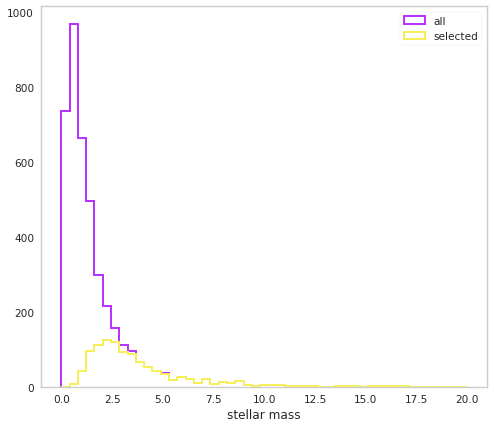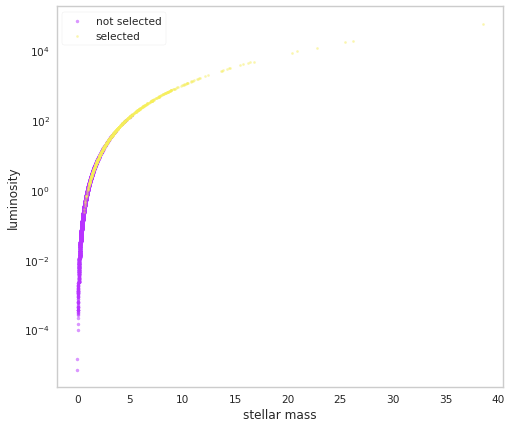Stellar Mass-Luminosity Bias
Suppose that stars have a mass-luminosity relationship such that \(L \propto M^3\). If we have a flux-limited survey, it will bias us towards observing more massive stars which are not representative of the full mass distribution. Let’s see how to set this up in popsynth.
Setup the problem
First, we will assume that we have some initial mass function (IMF) for our stars that describes how there masses are distributed. For simplicity, we will assume that this IMF is just a log-normal distribution:
[1]:
%matplotlib inline
import matplotlib.pyplot as plt
from jupyterthemes import jtplot
jtplot.style(context="notebook", fscale=1, grid=False)
purple = "#B833FF"
yellow = "#F6EF5B"
import networkx as nx
import numpy as np
import warnings
warnings.simplefilter("ignore")
import popsynth
# create a sampler for mass
# we do not directly observe the mass as it is a latent quantity
initial_mass_function = popsynth.LogNormalAuxSampler(name="mass", observed = False)
We now assume the dependent variable is the luminosity, so we need a DerivedLumAuxSampler that generates luminosities given a mass:
[2]:
class MassLuminosityRelation(popsynth.DerivedLumAuxSampler):
_auxiliary_sampler_name = "MassLuminosityRelation"
def __init__(self, mu=0.0, tau=1.0, sigma=1):
# this time set observed=True
super(MassLuminosityRelation, self).__init__("mass_lum_relation", uses_distance=False)
def true_sampler(self, size):
# the secondary quantity is mass
mass = self._secondary_samplers["mass"].true_values
# we will store the log of mass cubed
self._true_values = 3 * np.log10(mass)
def compute_luminosity(self):
# compute the luminosity
# from the relation
return np.power(10., self._true_values)
luminosity = MassLuminosityRelation()
Now we can put everything together. First, we need to assign mass as a secondary quantity to the luminosity
[3]:
luminosity.set_secondary_sampler(initial_mass_function)
Finally, we will use a simple spherical geometry to hold our stars. We will also put a hard flux limit on our survey to simulate a flux-limited catalog.
[4]:
pop_gen = popsynth.populations.SphericalPopulation(1, r_max=10)
# create the flux selection
flux_selector = popsynth.HardFluxSelection()
flux_selector.boundary = 1e-2
pop_gen.set_flux_selection(flux_selector)
# now add the luminisity sampler
pop_gen.add_observed_quantity(luminosity)
Now let’s draw our survey.
[5]:
pop = pop_gen.draw_survey(flux_sigma=0.5)
We can now look at the distribution of the masses:
[6]:
fig, ax = plt.subplots()
bins = np.linspace(0,20,50)
ax.hist(pop.mass,
bins=bins,
label='all',
color=purple,
histtype="step",
lw=2
)
ax.hist(pop.mass[pop.selection],
bins=bins,
label='selected',
color=yellow,
histtype="step",
lw=2
)
ax.set_xlabel('stellar mass')
ax.legend()
[6]:
<matplotlib.legend.Legend at 0x7feb7ce83250>

We can see that indeed our selected masses are biased towards higher values.
Let’s look in the mass-luminostiy plane:
[7]:
fig, ax = plt.subplots()
bins = np.linspace(0,20,50)
ax.scatter(pop.mass[~pop.selection],
pop.luminosities_latent[~pop.selection],
label='not selected',
color=purple,
alpha=0.5,
s=10
)
ax.scatter(pop.mass[pop.selection],
pop.luminosities_latent[pop.selection],
label='selected',
color=yellow,
alpha=0.5,
s=5
)
ax.set_xlabel('stellar mass')
ax.set_ylabel('luminosity')
ax.set_yscale('log')
ax.legend()
[7]:
<matplotlib.legend.Legend at 0x7feb79aa1eb0>
